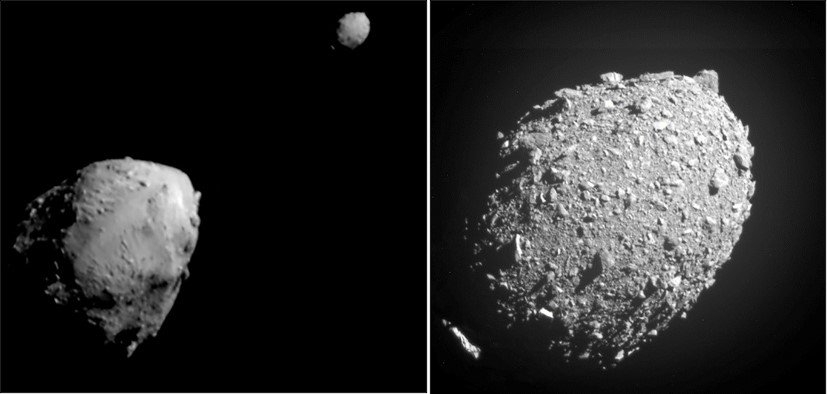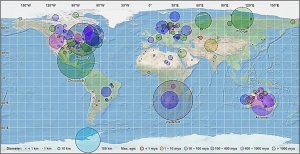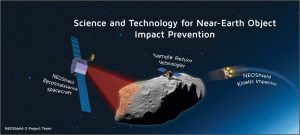
Planetary Defence: Mitigating Threats From Space!

Asteroid Didymos (L) and Dimorphos 2.5 minutes before impact; the last complete image of Dimorphos, taken by DART 12 Km from the asteroid & 2 seconds before impact.
At exactly 7:14 PM Eastern Daylight Time on 26 September (4:44 AM IST on 27 September), Mission Control at Johns Hopkins Applied Physics Laboratory in Maryland, US, announced the collision of NASA’s Double Asteroid Redirection Test (DART), a 570 Kg spacecraft, with the 530 feet wide asteroid Dimorphos, at a speed of 22,530 Kmph and at a distance of 11 Million Km from Earth! The asteroid itself is a part of a ‘binary’ asteroid system involving another, larger, 2,560-foot asteroid called Didymos. Neither asteroid presently posed a threat to our planet. DART was launched aboard a SpaceX Falcon 9 Rocket from Vandenberg Space Force Base in California, US on 03 November 2021 and underwent a 10-month long space odyssey before impact!
The DART test was the world’s first kinetic impact asteroid test, as part of the NASA’s overall Planetary Defence (PD) strategy and is expected to shorten the orbit of Dimorphos by about 1%, thus deflecting it from its present orbit- a demonstration of how a rogue, earth-bound celestial body might be deflected from impacting with our planet.
The success of the DART Mission is no mean achievement and has demonstrated a hithertofore elusive capability of negating a potentially disastrous, if not existential global threat from an inbound celestial body, which mankind has till now been powerless to evade. The mission represents a significant milestone in the quest for a PD strategy to obviate a looming risk from naturally occurring (and eventually even alien!?) inbound celestial impactors/threats.
What is Planetary Defence?
An apt representation is reproduced below:-
Planetary ‘Defense’ entails detecting, monitoring, understanding, and mitigating near-Earth objects, also known as NEOs. They are small objects in our solar system like asteroids and comets that come close to Earth. Whether or not an object is classified as a NEO depends on its orbit, size, and composition[1].
Can A Celestial Incoming Threat Be Existential?
Approximately 66 million years ago, a large asteroid with a diameter of approximately 10 Km, crashed into the Earth’s surface in the Yucatan Peninsula on Mexico’s East Coast, causing mass extinction of the dinosaurs. The Chicxulub Crater that was formed was ~150 Km in diameter and 20 Km in depth- the second-largest confirmed impact scenario on Earth which is intact for study. An even larger impact was caused by an asteroid-hit in Vredefort, South Africa, resulting in a since-eroded crater 160 Km in diameter. Earth is fortunate that this impact occurred 2.023 billion years ago, before the advent of advanced life forms!
We cannot rest our worries on the thought that such apocalyptic events are only relegated to the prehistoric times of a young universe. Recorded history is replete with such cataclysms. The 1908 Tunguska impact in Siberia, the largest impact in recorded history, is thought to have been triggered by an incoming meteorite of 30-40 m in diameter. The 2013 Chelyabinsk meteor burst, which caused many Russian cities to reel under its shock wave, is likely to have been the result of an incoming asteroid just 20 m across! The moon’s cratered surface is testimony to the fact that these events have been and continue to be in the realm of reality. The Lunar Planetary Observatory at the University of Arizona, US, opines that the Earth has been at the receiving end of more than 3 Million impact craters larger than 1 Km in diameter[2], which would have, at the lowest end of the scale, collided with an energy of 6 × 104 megatons (equivalent to an earthquake of magnitude 9.4 on the Richter scale)[3]. The after-effects of such a meteorite impact in a populated region would be unprecedently disastrous!

Earth Impact Database As Of November 2017:Source-wikipedia.org
The Evolution of Planetary Defence
In 1992, NASA sponsored a Near-Earth-Object (NEO) Interception workshop to evaluate the ramifications of intercepting potential-impact celestial bodies. The report recommended a coordinated survey to catalogue potential Earth impactors (Spaceguard was the moniker given to this collective effort). 1n 1998, NASA set itself the goal to catalogue 90% of NEOs with diameters of 1 Km or more (representing significant risk). Though the initial timeframe for this effort was set at 2008, efforts towards this are ongoing and have since achieved significant progress.
In the first concrete steps towards evolution of a PD strategy, the US National Science and Technology Council opined in June 2018 that the US was not prepared to deal with an asteroid impact event, leading to the development and issue of the ‘National Near-Earth Object Preparedness Strategy Action Plan’. This plan was designed to improve preparedness towards mitigating NEO impacts over the ensuing 10 years by organising and coordinating NEO-related efforts, including leveraging existing capabilities at the global level. The Lincoln Near Earth Asteroid Research (LINEAR), Spacewatch, Panoramic Survey Telescope and Rapid Response System (PANSTARRS) and Catalina Sky Survey (CSS) Programs of the US, the Campo Imperatore Near-Earth Object Survey (CINEOS) in Italy, the Asiago-DLR Asteroid Survey (ADAS)- a German-Italian Joint Venture and the Japanese Spaceguard Agency are some of the efforts towards this end. Two other efforts are significant in the Action Plan. The Asteroid Terrestrial-impact Last Alert System (ATLAS), funded by NASA and presently in operation, conducts scans aimed towards late detection of potential impactors- while this would leave little time to attempt deflection of such incoming threats, it would still accord sufficient warning for necessary evacuation/disaster management. The second effort is NEOShield, supported by the EU, which analyses realistic options for preventing NEO collision, including monitoring orbital behaviour of NEOs and their identification for deflection missions.
Further refinement in observation techniques has continued, with the above programs having demonstrated the capability to observe/fix present locations of potential NEO impactors in space and correctly predict their projected impact times/sites.
Today, the Minor Planet Center (MPC), which operates from the Smithsonian Astrophysical Observatory, US, is a key facet of PD and the global node for receipt, archiving and distribution of all data of NEOs. The MPC is sanctioned by the International Astronomical Union and is responsible for identification, designation and orbit computation of all NEOs.
Collision Avoidance Strategies (CAS)
CAS would fall into two overarching categories- Fragmentation or Delay. Fragmentation would involve impacting the NEO by various means to shatter it into smaller, harmless fragments. Delay would aim to alter the potential impactor’s trajectory with respect to the Earth by an amount that would be sufficient to deflect the orbit of the NEO off its collision path. Within these paradigms, various CAS have been promulgated, which can broadly be categorised based on mitigation type (deflection-changing the course of the NEO/ fragmentation- destruction of the NEO), energy source of the CAS (nuclear/ kinetic/electromagnetic/gravitational/solar) and approach methodology (interception-collision/rendezvous/remote- the latter two essentially concerned with deflecting loose rubble piles held together by gravity, against which a direct kinetic impactor would be ineffective). Some of these are elucidated below.
Nuclear CAS. Nuclear-based CAS could either envisage a direct/proximal impact or a stand-off impact. A surface/sub-surface/proximal nuclear blast on a NEO need not achieve complete fragmentation, but sufficient surface/sub-surface damage to achieve necessary deflection of its orbit. In addition to the blast itself, the radiation and heat effects would vaporise surface material and convert it into ejecta, or ejected plasma, which in turn would act as a ‘thrust-vector’, to deflect the NEO’s orbit. In case of NEOs which are large loose-rubble piles, a direct/proximal impact would not suffice, in which case a powerful, multi-megaton stand-off explosion/explosion at optimal distance so as not to fragment the rubble-pile, but still achieve deflection due to the shock-wave/waves, would be the CAS. A 2007 NASA study based on the 300m asteroid Apophis (previously predicted to have a 2.7% chance of collision in April 2029), calculated that a multiple-explosion stand-off CAS at a distance of 100m from the asteroid, achieved via a pre-emptive launch of these warheads on a carrier rocket, could deflect NEOs of these dimensions two years ahead of collision and larger potential impactors as much as five years before projected impact! This CAS could potentially be extended to comets, whose inbound velocities would be several times higher than asteroids and therefore pose a greater risk of damage, should collision occur. A ground-breaking study was commenced in 2011 at the Iowa Asteroid Deflection Center (ADC), US, to develop short-notice CAS strategies for 50-500m NEOs when the discovery-to-impact time was less than one year. This resulted in conceptualisation of the Hypersonic Asteroid Intercept Vehicle (HAIV), which would combine a kinetic impactor/surface detonator to create an initial crater to house a high-efficiency follow-on nuclear explosion, thus generating a rocket-nozzle type thrust within the crater to suitably deflect the asteroid. Computer-modelling was then used to work out the number of HAIVs required, based on the size of the NEO and time available till impact. The ADC has since collaborated with the Danish Emergency Asteroid Defence Project (EADP) to develop a HAIV carrier. In case nuclear CAS is required in the case of large NEOs, it is intended to employ devices which would typically have a yield upto 5 MT, a fraction of that required for stand-off nuclear CAS. A US Government Accountability Report of 2014 mentions that the US National Nuclear Security Administration, responsible for safety, security and effectiveness of US nuclear weapons, retains secondary stages of nuclear weapons for envisaged use in PD.
Kinetic CAS. NASA is in agreement that non-nuclear kinetic impactors represent a stable and feasible option to alter the momentum of small, single-body NEOs by direct-impact spacecraft. This method has been demonstrated by DART, as elucidated. DART is NASA’s contribution to the Asteroid Impact and Deflection Assessment (AIDA) missions, which also include a follow-up spacecraft, HERA, scheduled to rendezvous with the Dimorphos-Didymos asteroid system in December 2026, to measure change in mass, velocity and orbit of Dimorphos as a result of DART’s impact, thus enabling extrapolation of this data to other CAS missions. EU’s NEOShield Mission is a similar kinetic CAS. It must be noted that only very minor velocity changes, of the order of sub m/sec, are required to effect required orbital changes, which make the kinetic CAS a feasible option.

Illustration of NEOShield:Source- facebook.com/NEOShield/
LASER-Based CAS. Asteroid LASER Ablation envisages focussing a high-energy LASER beam on the NEO to vaporise/ ablate (remove) away a portion of the asteroid mass, thus causing a shift in momentum. This concept finds mention in a US Air Force white paper for Air Force 2025, titled ‘Planetary Defense: Catastrophic Health Insurance for Planet Earth’ and other contemporary publications. Another proposal is the Directed Energy System for Targeting of Asteroids and Exploration (DE-STAR) Project, which proposes a space-assembled, 1 km2, KW output, near-infrared LASER array to vaporise small NEOs. The US Beam Experiments Aboard A Rocket (BEAR) experiment might be ideally suited for such a space-based LASER application (read about BEAR @ https://chanakyaforum.com/directed-energy-weapons1/ ).
Other proposals, including using focused solar energy and use of an electromagnetic ‘mass-driver’ on the NEO’s surface to systematically eject mass from the NEO by providing low-energy impulses, are presently only likely to be in the realm of concept and are not discussed in this article.
In January this year, ATLAS, with four telescopes operating from Hawaii, Chile and South Africa, reached a key milestone by demonstrating the capability for complete survey of the dark sky for potential impactors in a 24-hour cycle, thus providing an all-sky surveillance umbrella for such threats.
Conclusion
While international, regional and domestic strife has seized mankind’s attention and eroded harmonious existence over the centuries, the global community is justified in their concern regarding the risk of space-based Armageddon. PD is an imperative requirement that can only develop and mature in a globally cooperative environment, due to the scale of peril represented and the niche technology required to mitigate this threat.
[1]www.seti.org
[2] www.esa.int
[3] www.astronomynotes.com
Disclaimer
The opinions expressed in this article are the author’s own and do not reflect the views of Chanakya Forum. All information provided in this article including timeliness, completeness, accuracy, suitability or validity of information referenced therein, is the sole responsibility of the author. www.chanakyaforum.com does not assume any responsibility for the same.
Chanakya Forum is now on . Click here to join our channel (@ChanakyaForum) and stay updated with the latest headlines and articles.
Important
We work round the clock to bring you the finest articles and updates from around the world. There is a team that works tirelessly to ensure that you have a seamless reading experience. But all this costs money. Please support us so that we keep doing what we do best. Happy Reading
Support Us





















POST COMMENTS (0)